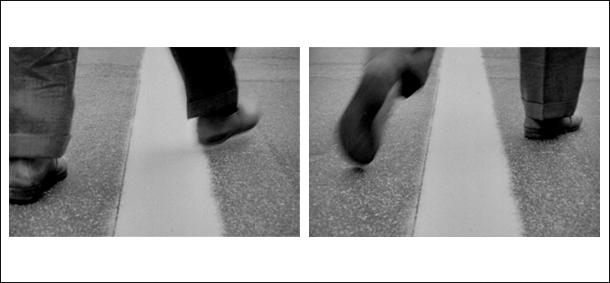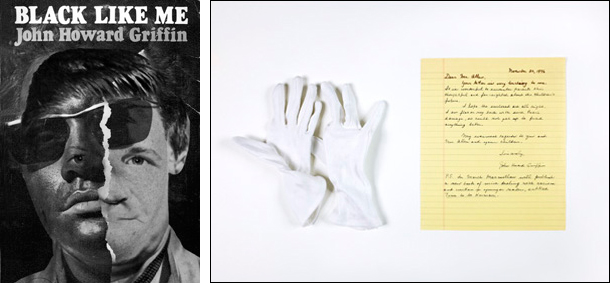| |
|
|
16. A Journey into Shame |
| |
Projects


The Letter of John Howard Griffin, 2013-2014, pigment print on fine art, 45 x 100 cm.

Crossing the line, 2014-2015, diptych, pigment print on fine art, 68,5 x 105 cm each.

Started in 2013. Photomontages, archives. The Letter from J. H. Griffin, 2013-2014, C-Print, 40 x 60 cm.

Started in 2013. Archives

Started in 2013. Archives
Mounir Fatmi is interested here in this ultimate experience of the Other, where Griffin has done everything to change his own skin to understand the life of the other and particularly, the place of an African-American in the United States in the 1960s.
mounir fatmi, 2013
|
|
| On the use of archives by mounir fatmi on Ibraaz Platform
Le Voyage dans la Honte est un projet rendant hommage à John Howard Griffin, écrivain journaliste américain blanc, né en 1920, réputé pour son combat contre les discriminations raciales. Lors de la Seconde Guerre mondiale, il perd la vue à la suite d’une projection d’éclats d’obus. Forcé de rentrer au Texas, il décide alors d’y étudier la philosophie.
Le taux de suicide croissant chez la population noire du sud des États-Unis, leur sentiment de désespoir, poussent J. H. Griffin a réalisé une expérience unique pour se rendre compte de la ségrégation subie par les Afro-Américains.
En 1959, il part dans le sud des États Unis afin d’y subir un traitement médical associé à des rayons ultraviolets dans le but de noircir sa peau.
Durant ses trois mois de voyage (Louisiane, Mississippi, Alabama et Géorgie), il éprouve un cauchemar : extrême pauvreté, promiscuité, misère, absence de droits.
Il décide finalement de retourner parmi les siens, et les difficultés, loin de s’estomper, vont aller croissantes. Les blancs ne lui pardonnent pas ce qu’il considère comme une trahison. Il est victime de menaces de mort et désignée comme traître, son portrait est placardé dans sa ville. Il meurt de diabète en 1980 dans le plus grand dénuement.
Néanmoins, Griffin recueillit un succès international grâce à son livre « Dans la peau d’un noir » et devînt un des membres du Mouvement des droits civiques ainsi qu’un militant des droits de l’homme.
Le projet “Le Voyage dans la Honte” pose la question de l’Autre.
Qui sont les autres était l’objet d’une vidéo de 1999, qui fait maintenant partie de la collection de la Cité de l’Immigration à Paris. Cette question est récurrente dans le travail de mounir fatmi comme dans les oeuvres The Blinding Light ou La Jambe Noire de l’Ange, oeuvres toutes deux inspirées de la peinture de Fra Angelico, La Guérison du Diacre Justinien. Deux saints, Saint Côme et Saint Damien greffent la jambe d’un Éthiopien récemment décédé sur le diacre Justinien endormi dont la jambe a été amputée.
Mounir Fatmi s’intéresse ici dans cette expérience extrême de l’Autre, où J.H. Griffin fait tout son possible pour changer la couleur de sa peau pour expérimenter la place de l’autre et particulièrement, la place d’un Afro-Américain aux États-Unis dans les années 60. Se mettre à la place de l’autre, jusqu’à risquer sa propre vie, c’est le processus qu’a choisi de mettre en lumière mounir fatmi.
Ce projet est divisé en deux parties: la première une vidéo de 25 minutes retrace l’expérience que John Howard Griffin a menée en 1960, sur la couleur de sa peau et l’influence qu’il a eu sur la mentalité des Américains, jusqu’à l’élection en 2008, puis en 2012, de Barak Obama, premièr président Afro-Américain des États-Unis.
La seconde partie est une installation englobant des articles, écrits et photographies prises par Griffin, et des images d’archives sur ce sujet.
|
|
A Journey into Shame is a project honoring John Howard Griffin, white American writer and journalist, born in 1920, known for his fight against racial discrimination. During the Second World War, he lost his sight as a result of a spraying shrapnel. Forced to return to Texas, he decided then to study philosophy.
The growing rate of suicide among the Black population in the southern United States, their sense of despair grow, JH Griffin has made a unique experience to realize segregation experienced by African Americans.
In 1959, he moved into the southern United States to undergo medical treatment combined with ultraviolet rays in order to blacken his skin.
During his three-month trip (Louisiana, Mississippi, Alabama and Georgia) he experiences a nightmare: extreme poverty, overcrowding, poverty, lack of rights.
He finally decides to return with his family, and difficulties, far from fading, will go increasing. Whites do not condone what they considered a betrayal. He suffered death threats and designated as a traitor, his portrait is plastered in his city. He died of diabetes in 1980 in the greatest poverty.
Nevertheless, Griffin gathered an international success with his book “Black Like Me” and became a member of the Civil Rights Movement and an activist for human rights.
This proposal “Journey into Shame” aims to raise the question of the Other.
Who are the others was the subject of a video of 1999, now part of the public collection of the Cité de l’Immigration in Paris, France. This question is raised through several works as for instance, The Blinding Light and the Angel’s Black Leg, both pieces based on Fra Angelico painting : The Healing of Deacon Justinian by Fra Angelico, a miraculous tale of transformation is told. Two saints, Cosmas and Damian, take the leg of a recently deceased Ethiopian man and sew it to the sleeping Deacon, whose own diseased leg has been amputated.
Mounir Fatmi is interested here in this ultimate experience of the Other, where J.H. Griffin has done everything to change his own skin to understand the life of the other and particularly, the place of an African-American in the United States in the 1960s. His will to go so far he risks his health to experience to become the Other, as one cannot understand one situation as long as it is not lived, is mesmerizing and Mounir wants to highlight this process.
The project is divided into two parts: the first; Video of 25 minutes traces the experience that John Howard Griffin led in 1960 the color of his skin and his influence in the mentality Americans until the election in 2008, then in 2012, Obama, First African American President of the United States.
The second part is an installation comprising articles writings and photographs taken by Griffin, as well as documents and images gathered on the subject archives. |
|
|
|